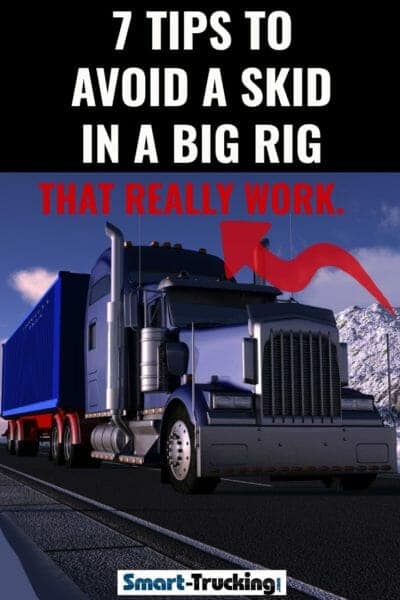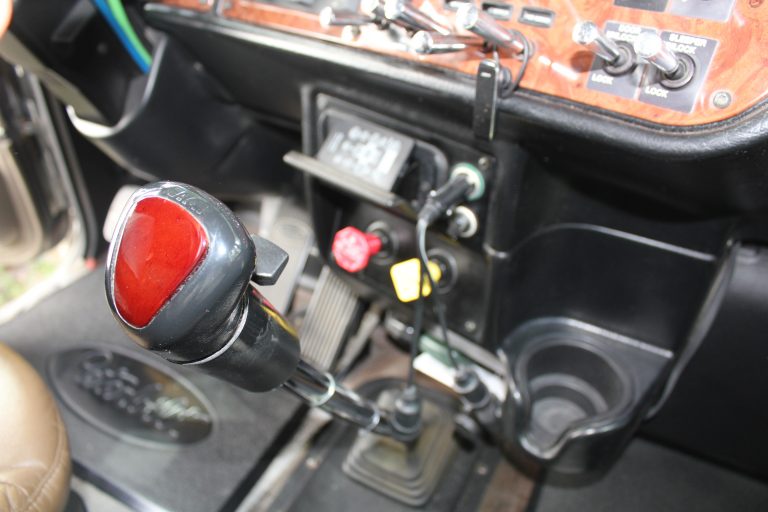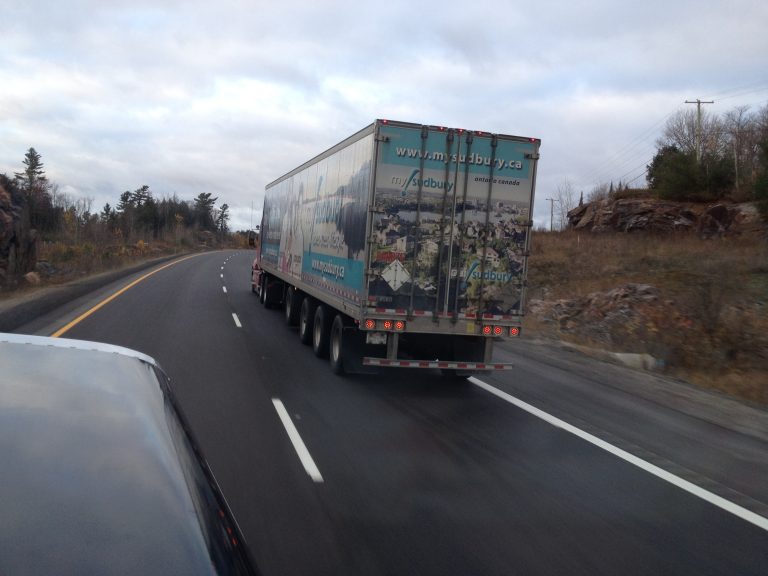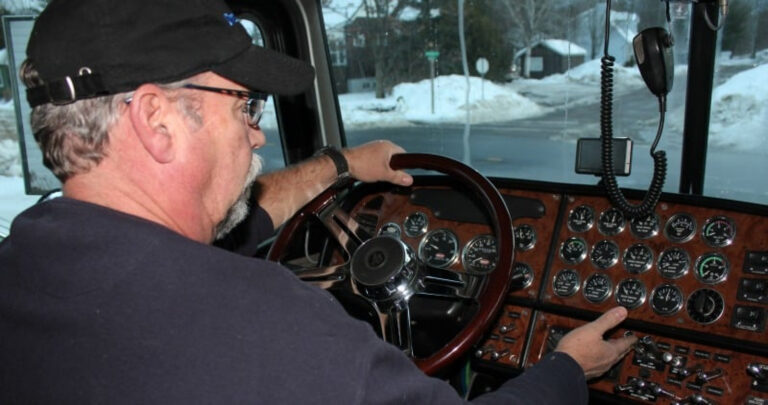7 Tips to Avoid A Skid in a Big Rig That Really Work

One of the most feared moments for a truck driver is losing control of the rig. Braking a tractor trailer is an important skill for a professional truck driver.
There’s a right way and a wrong way to brake. Learning truck driver skid control can prevent accidents before you have to deal with correcting them. Most of it is straight-forward safety but there are a few techniques that can also help on windy, icy or steep routes.
1. Avoid Skidding Your Truck by Safely Braking
My first word of advice to avoid skidding your big rig is to NEVER slam on the brake pedal hard. This can cause at least one of the duals to lock up. When one of the duals locks up, it can cause the trailer to start to slide, especially on slippery roads.
If the brakes are poorly set up, this can lock up one of the steering axle brakes. This can cause the truck/trailer unit to walk sideways, which is bad news!
Proper braking technique for a big rig is to ease pressure on the brake pedal. Then feather down the pedal gently and slowly, applying pressure a few times.This motion imitates the same motion that a properly functioning ABS system would do.
This is the ideal way to slow the vehicle down, without putting it into a skid.
2. Pay Attention to Stopping Distances
Stopping distances for your commercial truck depend on several factors including how fast you are going, how much weight your are hauling, road conditions and the height of your load. You should expect it to take twice as long to stop in a commercial truck as it would take in a passenger vehicle. Always OVER estimate stopping distance. This will help avoid a need to make an urgent stop that can cause a skid or jackknife in your tractor trailer.
Related > Tips For Proper Use of Controlling Your Speed Using Cruise Control
3. Use The Jake Brake
The Jake Brake is also another tool to help to slow your semi-truck down and prevent a skid or slide. Not all truck drivers will agree with me, but I sometimes use the jake even on slippery surfaces. Do whatever you feel comfortable with or that matches your level of experience. Here are a few tips when using the jake to slow down your rig and avoid skidding. Keep in mind that jake braking can be banned in certain residential areas.
4. Use the Jake Brake in Lowest Position
Should the driver have the space or the chance to drop a few gears, this will also help to slow the truck down. If I’m using the jake to avoid a skid in my rig, I have the jake set in the lowest position.
In the low position, my truck’s Caterpillar engine activates the jake on only one of the three heads, which is 2 cylinders activated.
In medium position, it activates 2 of the 3 heads, which activates 4 cylinders.
In high position, it activates all three of the heads, which activates all 6 cylinders of the engine, to slow the truck down.
Related > More Tips On How to Use the Jake Brake
5. Descend Hills Slowly to Avoid a Tractor Trailer Skid
If you are descending a steep slope, always proceed on your descent slowly. Descending a slippery hill too fast can often be fatal. Maintain a slow speed to avoid a tractor trailer skid.
Related > How to Climb a Slippery Slope in a Big Rig
6. Feather the Brakes
It’s vital to ride the jake as you descend the hill and feather the brakes.
Feathering the brakes when descending a hill, will help to prevent a slide. Feathering brakes mimics the effects of anti-lock braking system or ABS. ABS is very helpful if your tires lock up on a patch of ice. It will kick in and feather your brakes for you to prevent a skid. However, ABS does not always work correctly and should not be depended on.
7. Keep Your Trailer Straight When Braking.
It’s also important to keep the truck/trailer unit straight when braking, if possible. This will help also to avoid a slide. Otherwise, the weight of the trailer could cause a problem and cause the unit to slide.
Unfortunately, once the unit goes into a skid, it can be nearly impossible to catch up to it and correct a slide. It is better to do your best to avoid a skid when driving your commercial truck rather than risk having to correct it.
If it is necessary to straighten the unit out, do so on a straight stretch of road. Avoid trying to straighten out on a curve. It is much more difficult to straighten out when the unit is out of shape.
If you try to correct the position of the unit on a curve, this can cause the unit to slide. This could result in repeated over-correction as you try to both straighten out and stay on the road.
More > How To Handle a Jack Knife Skid
Avoiding a Skid in Your Semi-Truck When Mountain Driving
Mountain driving requires extra attention to braking technique. It’s even more vital to feather the brake pedal to slow the truck.
The feathering application gives air the chance to get in amongst the brakes and the drum which helps cool the system. When applying excess pressure and riding the brakes, there will be a great deal of friction and heat buildup, due to a lack of air circulating around the brakes. Brakes then heat up very quickly.
When the brakes heat up, they will suffer from ‘brake fade’, or temporary loss of function of your brakes. Sometimes, this can result in full brake failure.
Feathering is especially helpful on mountain roads. Mountain roads are windy and emergency pull offs are few and far between. You want to avoid burning out your brakes and also prevent lock up. Go slow and steady and feather your brakes. This method can be useful in the event that the ABS system is not working correctly.
When the ABS is not working, it is very dangerous to grab the steering wheel, hit the brakes hard and pray everything works out. This is just the wrong approach.
ABS was designed to help control the braking for the driver, when it is working properly. If the ABS system is working correctly, it should do the work for the driver. However, due to corrosion on trucks from the weather and road salt, the ABS system doesn’t always work well 100% of the time. You cannot always test to make sure your ABS is working and it may surprise you if it doesn’t kick in when you need it most.
Mountain driving is full of curves and unpredictable weather. Make sure you have your basics down. Go carefully, feather your brakes, utilize your jake brake, and do your best to only brake heavily on straight roads. The same could be said for most roads. Maintain a good awareness of your environment and always over-estimate your stopping distances.
If you aren’t totally comfortable on the route you’re taking then drive slowly. Better safe than flipped!
Related > Trucker Tips For Mountain Driving
The Most Important Rule to Follow When Driving in the Mountains
- One of my key rules when driving a truck, is to do everything carefully and methodically. Never be in a rush to do anything. Descending a mountain or steep grade is one of those times when this rule is of vital importance.
WATCH THE VIDEO VERSION OF THE ARTICLE!




